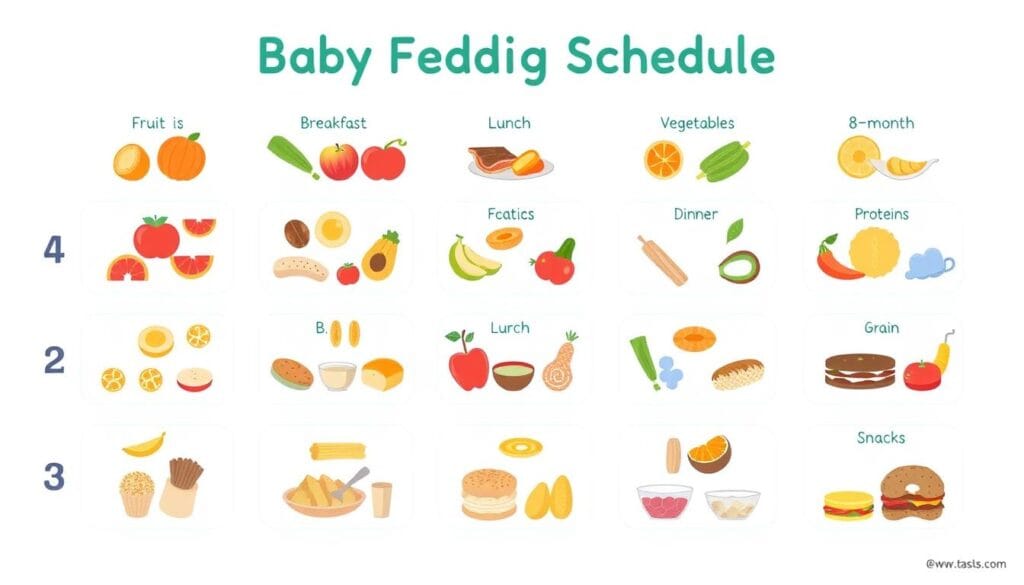Wondering what’s best for your 8-month-old baby’s food? Moving from milk to solid foods is both fun and tough. But, with the right help, you can make sure your baby gets all the nutrients they need. So, what should an 8-month-old eat?
When your baby hits 8 months, their diet and eating habits change. It’s key to start them on a variety of foods rich in nutrients. This balance helps them grow well, mixing milk and solid foods right.
Table of Contents
Understanding Your 8-Month-Old’s Nutritional Needs
Your 8-month-old baby is growing fast and needs the right nutrients for health. They usually weigh 16 to 23 pounds and need 750-900 calories daily. About 400-500 calories should come from breast milk or formula.
Caloric Requirements and Essential Nutrients
Focus on a diet full of protein, iron, calcium, and vitamins A, C, and D for your 8-month-old. These nutrients support growth, brain development, and health.
Balance Between Milk and Solid Foods
It’s key to balance milk and solid foods as your baby grows. Offer 24-32 ounces of breast milk or formula daily. Also, introduce baby-friendly fruits, vegetables, cereals, and mashed or pureed meats. This mix ensures your baby gets all the necessary nutrients.
Signs of Nutritional Adequacy
Look for signs your 8-month-old is getting enough nutrients. They should have steady weight gain, regular bowel movements, and reach developmental milestones. A varied diet rich in essential nutrients for babies supports a balanced diet for infants.
Transitioning from Purees to Solid Foods
As your 8-month-old baby grows, it’s time to start transitioning from purees to solid foods. This exciting phase of baby-led weaning and solid food introduction lets your little one explore new textures and flavors. They also get to enjoy self-feeding with finger foods for babies.
Babies usually start eating table foods around 8-9 months. Some might start as early as 7 months. It’s best not to wait too long, aiming to introduce solid foods between 7 to 10 months. Signs that your baby is ready include grabbing at food, making chewing motions, and picking up small objects.
Start with one solid meal a day and gradually increase to two or three as your baby adapts. Begin with soft, mashed foods and then move to more textured options like meltable puffs. These dissolve easily and offer a satisfying crunch. Show your baby how to chew by demonstrating it while they watch.
- Introduce table foods in a distraction-free environment to allow for focused attention.
- Seat your baby in a high chair during mealtimes to ensure safety and prevent choking.
- Gently guide your baby’s hand to their mouth during initial attempts, and be patient and encouraging throughout the learning process.
Remember, breast milk or formula should still be the main source of nutrition during this transition. Offering a variety of textures and flavors helps expand your baby’s palate. It also develops their motor skills through self-feeding. Enjoy this exciting journey of baby-led weaning and solid food introduction as your little one discovers the wonders of solid foods.
| Key Milestones | Timeline |
|---|---|
| Start of Pureed Solids | Around 6 months |
| Transition to Soft Table Foods | Around 9 months |
| Full Transition to Table Foods | 9-12 months |
Best Food for 8 Month Old: Recommended Food Groups
When your baby is 8 months old, it’s time to introduce more foods. This is a key time for their growth. Let’s look at the best foods for your 8-month-old.
Fruits and Vegetables
Give your baby soft, mashed fruits and veggies like bananas, avocados, and sweet potatoes. Also, try peas and carrots. These foods are full of vitamins, minerals, and fiber.
Proteins and Iron-Rich Foods
Add pureed meats, beans, lentils, and egg yolks to their meals. These foods help build muscles and give iron for healthy blood cells.
Whole Grains and Cereals
Start with iron-fortified cereals, soft breads, and easy pasta. These foods give energy and extra nutrients.
Feed your baby 2-4 ounces of each food group at meals. Introduce one new food at a time. Watch for allergies. Don’t add sugars, salt, or honey. Make sure foods are soft to avoid choking.
With a balanced diet, your 8-month-old will grow well and hit important milestones. Try new recipes and give your child the best foods for their age.
Creating a Balanced Feeding Schedule
It’s important to have a regular feeding schedule for your 8-month-old. They usually do well with 4-5 milk feedings and 2-3 solid meals a day. Make sure to give solids before milk to help them try new tastes and textures.
Here’s a daily feeding plan for an 8-month-old:
- 7:00 AM – Wake up and nurse/bottle
- 8:00 AM – Breakfast (e.g., mashed banana, sweet potato, scrambled egg)
- 11:00 AM – Nurse/bottle
- 12:00 PM – Lunch (e.g., small pieces of meat, cooked vegetables, yogurt)
- 3:00 PM – Nurse/bottle
- 5:30 PM – Dinner (e.g., pureed beans, soft-cooked carrots, small slices of bread)
- 7:00 PM – Bedtime nurse/bottle
This is just a sample plan. Adjust it based on your baby’s hunger and your family’s schedule. Make sure to offer a variety of foods at each meal. This ensures your 8-month-old gets all the nutrients they need, like iron, zinc, choline, and DHA.
| Nutrient | Importance for 8-Month-Old | Food Sources |
|---|---|---|
| Iron | Supports red blood cell production and brain development | Meat, fortified cereals, beans, lentils |
| Zinc | Aids immune function and wound healing | Meat, poultry, seafood, dairy, beans |
| Choline | Promotes brain and nervous system health | Eggs, meat, poultry, dairy, beans |
| DHA | Supports eye and brain development | Fatty fish, eggs, fortified foods |
By sticking to a balanced feeding schedule and giving a variety of foods, you help your 8-month-old grow and thrive.

Safe Food Preparation and Portion Sizes
As your 8-month-old starts eating more solid foods, safety and nutrition are key. Make sure to prepare baby food with the right textures to avoid choking.
Appropriate Textures and Consistencies
Begin with smooth purees and then move to soft, mashed, and finely chopped foods. This helps your baby learn different textures. Offer 2-4 ounces of each food group per meal, adjusting as needed.
Choking Hazards to Avoid
- Whole grapes, cherry tomatoes, or other round, firm foods should be cut into small pieces.
- Avoid hard, crunchy items like nuts, popcorn, and raw vegetables until your baby is older.
- Remove seeds, pits, and tough skins from fruits and vegetables before serving.
- Cook foods until they are soft and easily mashable with a fork or spoon.
Always watch over meal times and make sure your baby is in a safe, secure high chair. Introducing different textures helps your baby’s oral motor skills and prevents feeding problems later.
“Proper food preparation and portion control are essential for keeping your baby safe and healthy during the weaning process.”
Introducing New Foods and Managing Food Allergies
Introducing new foods to your 8-month-old can be both exciting and daunting. It’s important to explore different flavors and textures for their development. But, you must also watch out for potential food allergies.
Start by introducing new foods one at a time. Wait 3-5 days before trying another new item. This helps you spot any signs of an allergic reaction, like hives or vomiting. Common allergens like peanuts and eggs can be introduced early, but always check with your pediatrician.
Begin with small amounts of new foods and gradually increase the portion size. This approach not only helps prevent food allergies but also prevents picky eating. Even if your child doesn’t like a food at first, keep offering it. It may take multiple tries for them to accept it.
About 8% of children under 5 have food allergies. The most common allergens are eggs, milk, peanuts, tree nuts, soy, and wheat. While severe reactions are rare, knowing the signs of an allergic response is crucial. If you notice any concerning symptoms after introducing a new food, contact your pediatrician right away.
By introducing allergens to babies early and safely, you can help them develop a healthy relationship with food. This reduces the chance of lifelong food allergies. With patience, persistence, and careful attention to your child’s reactions, you can confidently navigate the journey of new food introduction.
| Common Food Allergens | Typical Symptoms | Likelihood of Resolution |
|---|---|---|
| Peanuts, Tree Nuts, Fish, Shellfish | Hives, Swelling, Difficulty Breathing | Typically Lifelong |
| Milk, Eggs, Wheat, Soy | Rash, Digestive Issues, Nasal Congestion | Often Resolve in Childhood |
Essential Kitchen Tools for Baby Feeding
As your little one starts their food journey, the right tools are key. You’ll need feeding gear and storage solutions. These essentials will make mealtime easier and ensure your baby gets tasty, healthy food.
Feeding Equipment and Storage Solutions
First, get a good high chair for safe and comfy eating. You’ll also need BPA-free bowls, plates, and cups. Soft-tipped spoons, like the Olababy Straw Cup and Upward Spoons, are great for introducing solids.
For making baby food, a strong food processor or blender is essential. The Vitamix and Baby Brezza are top choices. Use ice cube trays to freeze and store your homemade food easily.
Safety and Cleaning Guidelines
Cleaning and sterilizing feeding gear is vital for your baby’s health. Always follow the maker’s cleaning tips. Mesh feeders, like the Nuby Dipeez, are safe for soft fruits and veggies.
Watch out for choking hazards and always watch your baby eat. A Crinkle Cutter is perfect for toddlers, helping with the right food textures.
With the right tools and a focus on safety, you’re ready for the baby food world. You’ll give your child yummy, healthy meals that help them grow.
Establishing Healthy Mealtime Routines
Creating a positive family mealtime habits and a calm baby feeding environment is key. It helps in developing mealtime routines for infants. A distraction-free setting for meals together is crucial for healthy eating habits.
Let your baby explore foods with their hands. This lets them enjoy textures and flavors. Listen to their hunger and fullness signs, and don’t force them to eat. A regular mealtime routine makes your baby feel secure and happy.
As your baby gets older, let them feed themselves. This boosts their independence and shows them the value of healthy eating. Remember, it’s okay if they make a mess while learning.
“Mealtimes should be a calm, enjoyable experience for both you and your baby. By creating a nurturing environment and responsive feeding practices, you lay the foundation for a lifetime of healthy eating habits.”
Discover your baby’s unique mealtime likes and rhythms. With planning and love, you can build a family mealtime habits. This will create a positive baby feeding environment and support your child’s growth.

Breast Milk and Formula Integration
When you start adding solid foods to your baby’s diet, it’s important to keep the right balance. Make sure your baby gets 24-34 ounces of breast milk or formula each day. This is in addition to the solid foods you introduce.
Maintaining Proper Hydration
Give breast milk or formula first, before solid foods. This ensures your baby gets enough nutrients. Also, add 2-3 ounces of water with meals to help with digestion and teach cup use.
Watch your baby’s wet diapers and energy to see if they’re getting enough water. Adjust as needed to keep them hydrated.
Balancing Liquid and Solid Nutrition
As your baby eats more solids, you can slowly cut back on breast milk or formula. Listen to your baby’s body and adjust accordingly. Always check with your pediatrician for the best balance.
Keep night feedings if your baby still needs them. It helps with growth and comfort.

1 thought on “Best Food for 8 Month Old: Complete Feeding Guide”
Comments are closed.